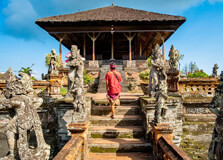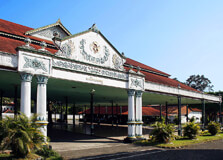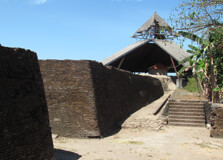
- Home
- Travel Packages
- Top Destination
-
Travel Attraction
By Category
Top Attraction

- Travel Agents
- Car Rentals
- Hotels

The Klungkung Palace, also known as Puri Agung Semarapura, is a historical landmark located in the Klungkung regency of Bali, Indonesia. The palace was once the residence of the royal family of Klungkung and served as the center of governance and justice in the region. Timings Of Klungkung Palace The Klungkung Palace is open to visitors every day from 9:00 AM to 5:00 PM. Entry Fee The entry fee for the Klungkung Palace is IDR 12,000 for adults and IDR 6,000 for children. Required Time And Restricted Items Visitors typically spend around 1-2 hours exploring the palace. It is advised not to bring food, pets, or large bags inside the palace premises. Architecture Of Klungkung Palace The architecture of the Klungkung Palace is a blend of Balinese and European influences. The palace features intricately carved stone walls, traditional Balinese paintings, and beautiful courtyards. Best Time To Visit The best time to visit the Klungkung Palace is during the morning hours when the weather is relatively cooler and the palace is less crowded. How To Reach The Klungkung Palace is located in Semarapura, the capital of the Klungkung regency. It is easily accessible by car or motorcycle from popular tourist areas in Bali such as Ubud and Sanur. History Of Klungkung Palace The Klungkung Palace has a rich history dating back to the late 17th century when it was built by the first king of Klungkung. The palace played a significant role in the governance of the region and was the site of important royal ceremonies. Inside Klungkung Palace Inside the Klungkung Palace, visitors can explore the main pavilion known as Bale Kambang, which features a ceiling adorned with beautiful paintings depicting Hindu epics. The palace also houses a museum showcasing traditional Balinese artifacts and historical relics. Traveling Tips It is recommended to wear appropriate clothing covering the shoulders and knees when visiting the Klungkung Palace as a sign of respect to the local culture. Visitors are also advised to carry sufficient water and sunscreen due to the tropical climate. Hotels Near Klungkung Palace With Names Some of the hotels near the Klungkung Palace include: Klungkung Beach Hotel Puri Oka Beach Bungalow The Nirwana Resort and Spa Nearby Tourist Spots Of Klungkung Palace Some of the nearby tourist spots to visit after exploring the Klungkung Palace are: Goa Lawah Temple Taman Ujung Water Palace Bukit Jambul Rice Terraces
Explore More
The Kraton Palace, also known as the Sultan’s Palace, is one of the most iconic landmarks in Yogyakarta, Indonesia. It serves as the cultural and historical center of the city and is the official residence of the Sultan of Yogyakarta. This magnificent palace is not just a residence but a symbol of Yogyakarta’s royal heritage, offering a glimpse into the rich cultural traditions and history of the region. Built in 1755 by Sultan Hamengkubuwono I, the Kraton is a sprawling complex of beautifully preserved buildings, courtyards, and gardens. It also functions as a museum, showcasing the arts, culture, and historical artifacts of the Yogyakarta Sultanate. How to Reach Kraton Palace, Yogyakarta The Kraton Palace is centrally located in Yogyakarta, making it easily accessible by various modes of transport. If you are arriving by air, the nearest airport is Adisucipto International Airport, which is about 9 kilometers (5.5 miles) from the Kraton. From the airport, you can take a taxi or use ride-sharing apps like Gojek or Grab to reach the palace. If you are already in the city, the Kraton Palace is located close to many other major attractions, such as Malioboro Street, so it is quite easy to get there by walking or by using a local public transportation option like the city bus or becak (traditional rickshaw). You can also rent a bicycle or a motorbike, which are convenient for getting around the city. Weather at Kraton Palace, Yogyakarta The weather in Yogyakarta is tropical, with warm temperatures year-round. The city experiences two main seasons: the rainy season, which lasts from November to March, and the dry season, which runs from April to October. The temperature in Yogyakarta typically ranges from 25°C to 32°C (77°F to 90°F), making it a pleasant destination to visit throughout the year. However, if you plan to visit during the rainy season, be prepared for occasional heavy rain showers. It is advisable to check the weather forecast before your trip to plan accordingly. Timing of the Kraton Palace, Yogyakarta The Kraton Palace is open to visitors daily, but it is advisable to check the specific timings before visiting, as they may vary depending on the day or special events. Generally, the palace is open from 8:30 AM to 2:30 PM. It is recommended to arrive early in the morning to avoid crowds and to fully enjoy the peaceful atmosphere of the palace. On certain religious holidays or special occasions, the palace may have limited access, so be sure to confirm any schedule changes before your visit. Why is Kraton Palace Famous? The Kraton Palace is famous for several reasons. First and foremost, it is the seat of the Sultan of Yogyakarta and holds great cultural significance in the region. The palace is a symbol of the enduring monarchy in Yogyakarta, a city that is unique for its semi-autonomous status under the Sultan’s rule, even within the Republic of Indonesia. The palace complex itself is a stunning example of Javanese architecture, blending traditional elements with European influences. Visitors can admire the ornate design, intricate carvings, and the peaceful atmosphere within the palace grounds. It also houses a museum with an extensive collection of royal artifacts, including weapons, costumes, and ancient manuscripts that provide insights into the history and heritage of the Yogyakarta Sultanate. Additionally, the palace is famous for its cultural performances. Traditional Javanese music, dance, and shadow puppetry are often performed in the palace’s courtyards, offering visitors a chance to experience the rich cultural traditions of Yogyakarta. Entry and Visit Details about Kraton Palace, Yogyakarta The Kraton Palace is open to the public, and visitors can explore its historical and cultural wonders. The entry fee to the Kraton Palace is generally affordable, with prices ranging from IDR 15,000 to IDR 25,000 for adults. Visitors can purchase tickets at the entrance gate. It is important to note that the palace is an active cultural site, so visitors are expected to dress modestly. It is customary to wear appropriate attire, covering the shoulders and knees. Sarongs are available at the entrance for those who may not be appropriately dressed. Guides are available for hire at the entrance, offering a more enriching experience by explaining the history and significance of the various sections of the palace. Although English-speaking guides are available, it is always a good idea to inquire about availability beforehand. History and Architecture of Kraton Palace, Yogyakarta The Kraton Palace was built in 1755 by Sultan Hamengkubuwono I, who established the Yogyakarta Sultanate after a significant conflict with the Mataram Kingdom. The palace was designed to serve as the seat of the Sultan and his court, as well as a symbol of the power and influence of the royal family. Over the centuries, the palace has undergone various expansions and renovations, but it still maintains its original architectural elements. The architecture of the Kraton is a blend of Javanese, Islamic, and European influences, with a central courtyard surrounded by several pavilions, gates, and gardens. The main building is known as the ‘Pendopo,’ a grand pavilion used for royal ceremonies and gatherings. The interior of the palace features delicate carvings, traditional Javanese artwork, and beautiful decorations, reflecting the refined taste of the royal family. The layout of the palace is designed to follow Javanese cosmological principles, symbolizing the connection between the spiritual and earthly realms. Things to Do at Kraton Palace, Yogyakarta When visiting the Kraton Palace, there are several things to do to enhance your experience: Explore the museum: The Kraton Palace houses a museum with a rich collection of artifacts, including royal regalia, ancient weapons, traditional clothing, and ceremonial items that showcase the history of the Yogyakarta Sultanate. Attend a cultural performance: Be sure to check the schedule for traditional performances such as gamelan music, Javanese dance, and wayang kulit (shadow puppetry). These performances offer insight into the region's cultural traditions. Visit the gardens and courtyards: The palace grounds feature lush gardens and tranquil courtyards, perfect for a leisurely stroll or a quiet moment to take in the beauty of the surroundings. Learn about Javanese culture: The Kraton is a great place to learn about Javanese art, music, dance, and the history of the Sultanate. The palace offers an immersive cultural experience. Facts and Tips about Kraton Palace, Yogyakarta The Kraton Palace is still the official residence of the Sultan and his family, although it is open to the public for tours. The architecture of the palace is based on the Javanese philosophy of the universe, with the central courtyard representing the balance between the spiritual and physical worlds. Don’t forget to bring sunscreen and a hat, as much of the palace is outdoors and can get quite hot, especially during the dry season. If you plan to visit during special events or festivals, check the palace’s schedule in advance, as there may be cultural performances or royal ceremonies taking place. Take time to appreciate the fine details of the architecture, as many of the palace’s structures are adorned with intricate carvings and symbols that represent important aspects of Javanese culture.
Explore More
Fort Somba Opu, located in the city of Makassar, South Sulawesi, Indonesia, is one of the most significant historical landmarks in the region. This fort has witnessed centuries of history, from the height of the Gowa Sultanate to the arrival of the Dutch colonialists in the 17th century. Today, Fort Somba Opu serves as both a historical site and a popular tourist attraction, offering visitors insight into the rich cultural heritage of Makassar and the surrounding areas. With its historical importance and beautiful surroundings, Fort Somba Opu is a must-visit for history enthusiasts and those curious about Indonesia's past. How to Reach Fort Somba Opu, Makassar Reaching Fort Somba Opu is relatively straightforward. The fort is located about 15 kilometers to the south of the center of Makassar city. If you are traveling from the city center, you can take a taxi or ride-hailing services like Grab or Gojek, which will take you directly to the fort. The journey typically takes around 30 to 40 minutes, depending on traffic conditions. For those who prefer public transportation, local buses and minibuses are also available. However, taxis or private cars are more comfortable and convenient, especially for tourists. It’s advisable to hire a local guide or arrange a tour that includes transportation to ensure a smooth visit. If you're staying in nearby areas, walking to the fort could also be an option, though it might take longer. Weather at Fort Somba Opu, Makassar The weather in Makassar is typically tropical, characterized by warm temperatures and high humidity year-round. Fort Somba Opu is located in a coastal area, which influences the climate. The average temperature ranges between 24°C (75°F) and 32°C (89°F), making it generally warm and humid. The best time to visit Fort Somba Opu is during the dry season, which runs from May to September. During this time, the weather is relatively cooler and less humid, offering a more comfortable experience for sightseeing. However, the rainy season (October to April) brings more frequent rains, which can sometimes affect outdoor activities. It is best to check the weather forecast before planning your visit to avoid heavy rainfall. Timing for Fort Somba Opu, Makassar Fort Somba Opu is open to visitors every day, typically from 8:00 AM to 5:00 PM. These hours provide ample time for exploring the fort and its surroundings. It is advisable to visit the fort earlier in the day to avoid the midday heat and the possibility of crowds. If you are planning to take photos or enjoy the fort in a more peaceful atmosphere, visiting in the morning or late afternoon is ideal. The weather is usually more comfortable, and you'll have more time to explore without the heat becoming too overwhelming. Why Fort Somba Opu is Famous? Fort Somba Opu is famous for its historical significance. Built in the 16th century, it was the seat of the Gowa Sultanate, one of the most powerful sultanates in South Sulawesi. The fort played a central role in regional politics and trade, particularly in the 17th century when it became a hub for merchants and traders from all over Southeast Asia. Its fame further stems from the dramatic events of its history, including the Dutch siege in 1667, which led to the fall of the Gowa Sultanate. The fort was partially destroyed during this period, and today, only the remnants of its walls and structures remain. Despite the damage, the fort’s ruins continue to attract tourists and historians alike, who come to learn more about the region’s past. Entry and Visit Details for Fort Somba Opu, Makassar Visitors can enter Fort Somba Opu for a small entry fee. As of now, the fee is usually quite affordable, making it accessible to most tourists. The entrance fee helps maintain the site and fund preservation efforts, ensuring that future generations can continue to enjoy the historical significance of the fort. It’s recommended to visit the fort with a guide who can provide detailed information about its history, significance, and the events that transpired there. Many local guides are available at the entrance or through local tour agencies, and they can offer fascinating insights into the fort's history and its role in South Sulawesi's development. When visiting, make sure to bring comfortable shoes, as exploring the fort’s grounds involves walking over uneven surfaces. The site can get hot, so it’s also a good idea to bring water and sun protection like hats and sunscreen. History and Architecture of Fort Somba Opu The history of Fort Somba Opu dates back to the 16th century when it was built by the Sultan of Gowa, a powerful kingdom in South Sulawesi. The fort was strategically located on the banks of the Jeneberang River, providing excellent defense and control over the surrounding region. Its architecture reflected the grandeur and power of the Gowa Sultanate, featuring strong stone walls, tall watchtowers, and several entry gates. Throughout its history, Fort Somba Opu was a bustling center of politics and trade. In the 17th century, the Dutch East India Company laid siege to the fort, and after a prolonged battle, the fort was eventually captured and partially destroyed. Despite the destruction, some parts of the fort have been preserved and are still visible today, including remnants of the walls and the foundations of what was once a magnificent royal palace. Today, visitors can explore the ruins of the fort and imagine what it would have looked like in its prime. The remaining structures, while in ruin, still showcase the engineering prowess of the time, with large, thick stone walls and high fortifications designed to withstand enemy attacks. Things to Do at Fort Somba Opu, Makassar Visiting Fort Somba Opu offers a chance to step back in time and experience the history of Makassar and South Sulawesi. Here are some of the top things to do at the fort: Explore the Ruins: Walk around the remnants of the fort, where you can see the old stone walls, watchtowers, and foundation structures. The site is vast, and there is plenty to explore, making it ideal for history lovers and photographers. Learn about the History: Engage with local guides who can provide you with in-depth information about the fort's role in the history of the Gowa Sultanate and the Dutch colonial period. Photography: The fort's ancient architecture and surrounding landscape provide great opportunities for photography. The combination of old stone structures, greenery, and the river creates a picturesque setting. Visit the Museum: Inside the fort area, there is a small museum where you can learn more about the Gowa Sultanate and the fort’s history. The museum houses various artifacts, including pottery, weapons, and historical relics. Interesting Facts About Fort Somba Opu, Makassar Fort Somba Opu was originally built as a stronghold to protect the Gowa Sultanate from external threats and to establish control over the region. The fort was made of coral stone, a material that was readily available in the area, and it was designed to withstand sieges and attacks. During its peak, the fort housed the royal family, soldiers, and merchants, making it a bustling center of activity. The fort was partially destroyed during the Dutch siege of 1667, and it has never been fully rebuilt, but the ruins still stand as a reminder of its former grandeur. Today, Fort Somba Opu remains one of the most important cultural and historical sites in South Sulawesi, attracting thousands of visitors each year. Tips for Visiting Fort Somba Opu, Makassar Bring water and snacks, as there are no major facilities for food and drink within the fort area. Wear comfortable shoes, as you will be walking around the site, which includes uneven terrain and steps. Consider hiring a local guide to gain a deeper understanding of the fort’s history and significance. Make sure to bring sun protection, especially if you plan to explore during the afternoon, as there is limited shade on the site. Respect the historical site by not touching or disturbing the artifacts and structures.
Explore More